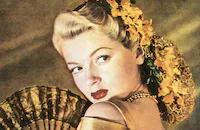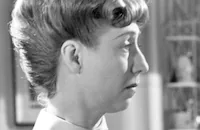Rich Man, Poor Girl

Brief Synopsis
Cast & Crew
Reinhold Schunzel
Robert Young
Lew Ayres
Ruth Hussey
Lana Turner
Guy Kibbee
Film Details
Technical Specs

Synopsis
Joan Thayer, the hard-working secretary to construction company president Bill Harrison, comes from a large, poor family. Joan and Bill are in love with each other, but Joan is reluctant to accept Bill's marriage proposal because he comes from a wealthy family, and she is afraid that he will one day start to think that he has married beneath him. When she invites Bill to her home for dinner, her kind but eccentric family do everything wrong, prompting an embarrased Joan to send Bill a note saying that they shouldn't see each other for a while. To prove to Joan that her family's poverty does not matter to him, Bill decides to move in with them, delighting Ma Thayer, but annoying Joan. Bill sleeps on the Thayers' old couch and soon becomes part of the family, much to Joan's continued displeasure. On Sunday morning, Bill takes them to his yacht, the Hilda , and they meet Sally, Bill's sister. Henry Thayer, Joan's cousin, is a radical thinker who professes a philosophy of "share the wealth." Because Henry is unable to find work, Bill secretly gets him a job with a company he owns in Brazil. Henry is suspicious when he is offered the job, and then, when the family goes to a party at Bills's and Henry finds out that Bill knows his new boss, Henry decides not to take the job. He then leaves the party, followed by all of the Thayers except Joan's younger sister Helen, who is trying to better herself in society. The next day, Sally tells the Thayers that Bill has announced that he is going to give all of his money away to worthy causes, and she plans to take him to court to prove his incompetence. The same day, Pa Thayer and Joan's brother Frank are fired from the hardware store in which they work, even though Pa has been there for fifty years. Bill seems to disregard Pa's misfortune and tells everyone that he wants to open a hospital for the small wage earner. The Thayers can't understand what has happened to Bill, but it is soon revealed that Bill and Sally were playing a trick on them to show that the Thayers were more concerned with his money than he. Bill then drives the family to their new home and tells Pa that he will be his partner in a hardware business. He also announces that he and Joan and going to be married the next day, that Henry is going to take the job in Brazil, and that Ma will be sole owner of the Hilda .

Director
Reinhold Schunzel
Cast

Robert Young

Lew Ayres

Ruth Hussey

Lana Turner

Guy Kibbee
Sarah Padden

Rita Johnson
Don Castle

Gordon Jones

Virginia Grey

Marie Blake
Dorothy Tennant
Edwin Maxwell
Barbara Bedford
Mitchell Lewis
Francisco Maran
Jules Cowles
Crew
Dr. William Axt
Edward Chodorov
Jerome Chodorov
Joseph A. Fields
Cedric Gibbons
Frank E. Hull
Ray June
Charles O'malley
Gabriel Scognamillo
Douglas Shearer
Dolly Tree
Edwin B. Willis

Videos
Movie Clip



Trailer
Film Details
Technical Specs

Articles
Rich Man, Poor Girl
Lana Turner in Rich Man, Poor Girl
In only her second appearance as an MGM star, Lana Turner demonstrated an energy and comic flair far in advance of her years (she was only 17) in Rich Man, Poor Girl. But despite some good reviews for her supporting performance in this 1938 romantic comedy, her comic turn was a far cry from the more somber, sensual roles that would mark her years as one of the studio's top stars in the '40s.
The plot -- a wealthy young businessman (Robert Young) who moves in with girlfriend Ruth Hussey's eccentric family to convince her they can make marriage work -- bears more than a passing resemblance to the same year's Oscar®-winning hit You Can't Take It with You. That may be only partly a coincidence. Rich Man, Poor Girl is adapted from Edith Ellis' 1925 play White Collars. MGM already owned the rights, having filmed it in 1929 as The Idle Rich, with Conrad Nagel, Bessie Love and Leila Hyams in the roles played by Young, Hussey and Turner, respectively. But their decision to dust off the property had to have been inspired by the stage success of You Can't Take It with You. It had opened on Broadway in 1936 and was still running at the time both films were released. News of director Frank Capra's planned film version at Columbia may have been another impetus. Working efficiently on the studio's back lot, director Reinhold Schunzel and producer Edward Chodorov filmed the MGM picture in just four weeks and actually had it in theatres nine days before the Capra film.
To find a writer to work on the new screenplay, Chodorov didn't have to go very far. He hired his brother, Jerome, who, with writing partner Joseph Fields, would achieve his greatest fame on Broadway with such hits as My Sister Eileen and Junior Miss. Producer Chodorov, who had come up through the writers ranks as well, had his own playwriting career. His woman-in-peril melodrama, Kind Lady, had been filmed by MGM in 1935 and would be re-made in 1951. At the time he made Rich Man, Poor Girl, he was a favorite on the lot, frequently lunching at studio head Louis B. Mayer's table.
Turner's casting as the leading lady's high-spirited sister, Helen, was hardly a major matter for the powers that be. She had come to the studio as a protégée of producer-director Mervyn LeRoy, who had first featured her prominently as the murder victim in Warner Bros.' They Won't Forget (1937). Her sexually charged performance helped her land her first MGM role, as the town vamp in Love Finds Andy Hardy (1938). The Hardy series was already a staple of the MGM production schedule, producing popular low-budget films that gave the studio a chance to try out young actresses opposite popular juvenile star Mickey Rooney.
The Hardy films had also provided a showcase for Hussey, who was playing her first starring role in Rich Man, Poor Girl after signing with the studio a year earlier. She had played a small role in Judge Hardy's Children (1938) and had small roles cut out of two other films there before the studio decided to try her in a lead. She would continue to alternate between minor leads and major supporting roles until her comic turn as a wise-cracking photographer in The Philadelphia Story (1940) brought her an Oscar® nomination and a comfortable berth at MGM as a reliable leading lady.
Rich Man, Poor Girl also marked the studio contract debut of Lew Ayres, who had starred at MGM earlier in his career as one of Greta Garbo's loves in her last silent film, The Kiss (1929). Although his performance as Hussey and Turner's brother showed his deftness with comedy (as had his work earlier in the year as Katharine Hepburn's drunken brother in Holiday), MGM would make primary use of his talents as the earnest young Dr. Kildare in a series of films (Turner would get another early showcase opposite him in Calling Dr. Kildare [1939]). He would remain a popular studio star until his stance as a conscientious objector during World War II led to his blacklisting. By the time reports of his heroic duty under fire as a member of the Medical Corps brought him back to public favor, MGM had dropped his contract.
Producer: Edward Chodorov
Director: Reinhold Schunzel
Screenplay: Joseph Fields, Jerome Chodorov
Based on the play White Collars by Edith Ellis
Cinematography: Ray June
Art Direction: Cedric Gibbons, Gabriel Scognamillo
Music: William Axt
Principal Cast: Robert Young (Bill Harrison), Ruth Hussey (Joan Thayer), Lew Ayres (Henry Thayer), Guy Kibbee (Philip Thayer), Lana Turner (Helen Thayer), Rita Johnson (Sally Harrison), Virginia Grey (Selma Willis), Marie Blake (Mrs. Gussler).
BW-72m. Closed captioning.
by Frank Miller

Rich Man, Poor Girl
Virginia Grey (1917-2004)
She was was born in Los Angeles on March 22, 1917, and was exposed to the film industry at a very young age. Her father, Ray Grey, was a Keystone Cop and acted in several other of Mack Sennett's comedies with the likes of Mabel Normand, Dorothy Gish and Ben Turpin. When her father died when she was still a child, Virginia's mother encouraged her to join the acting game and audition for the role of Eva for Uncle Tom's Cabin, a big budget picture for Universal Studios in the day. She won the role, and acted in a few more pictures at the studio: The Michigan Kid and Heart to Heart (both 1928), before she decided to temporarily leave acting to finish her schooling.
She returned to films after graduating from high school, and after bouncing around Hollywood doing bits for various studios, she hooked up with MGM in 1938. Her roles in her first few films were fairly non-descript: In Test Pilot and Ladies in Distress (both 1938), she did little more than look pretty, but in the following year she had scene-stealing parts in The Women (upstaging Joan Crawford in a delicious scene as a wisecracking perfume counter girl) and as the suffering heroine in Another Thin Man (both 1939).
Despite her versatility (she could handle comedy or drama with equal effectiveness), MGM would cast her in some above-average, but hardly starmaking movies: Whistling in the Dark, The Big Store (both 1941), and Tarzan's New York Adventure (1942). She left MGM in 1943 and became a freelance actress for several studios, but her material as a leading lady throughout the '40s were mediocre: Swamp Fire, House of Horrors (both 1946), and Mexican Hayride (1948) were sadly the more interesting films in her post-MGM period. But by the '50s she was a well-established character actress, appearing in fairly big-budget pictures: All That Heaven Allows, The Rose Tattoo (both 1955), Jeanne Eagels (1957).
In the '60s, Grey turned to television and found work on a variety of hit shows: Wagon Train, Peter Gunn, Bonanza, My Three Sons, I Spy, and several others; plus she also captured a a couple of notable supporting parts in these films: Madame X (1966), and Airport (1970), before retiring completely from acting in the early '70s. She is survived by her sister, Lorraine Grey Heindorf, two nieces and two nephews.
by Michael T. Toole
Virginia Grey (1917-2004)
Quotes
Trivia
The play originally opened in New York on 23 February 1923.
Notes
Working titles of the film were White Collars and It's Now or Never. According to a pre-production news item in Hollywood Reporter, Franchot Tone was originally set to play the lead opposite Lana Turner. Although Turner does appear in the film, the lead was played by Ruth Hussey and it is unclear whether Turner was originally set to play the role Hussey played or the news item indicated a leading role, rather than "the lead." Another Hollywood Reporter news item noted that this was the first American film of German-born director Reinhold Schunzel, who was brought to the United States six months before by M-G-M studio head Louis B. Mayer. Schunzel remained for many years in the United States where he directed several more films and appeared as an actor in many others. Another film based on Edith Ellis' play was made by M-G-M in 1929 under the title The Idle Rich. That film was directed by William C. de Mille and starred Conrad Nagle and Bessie Love (see AFI Catalog of Feature Films, 1921-30; F2. 2658).















